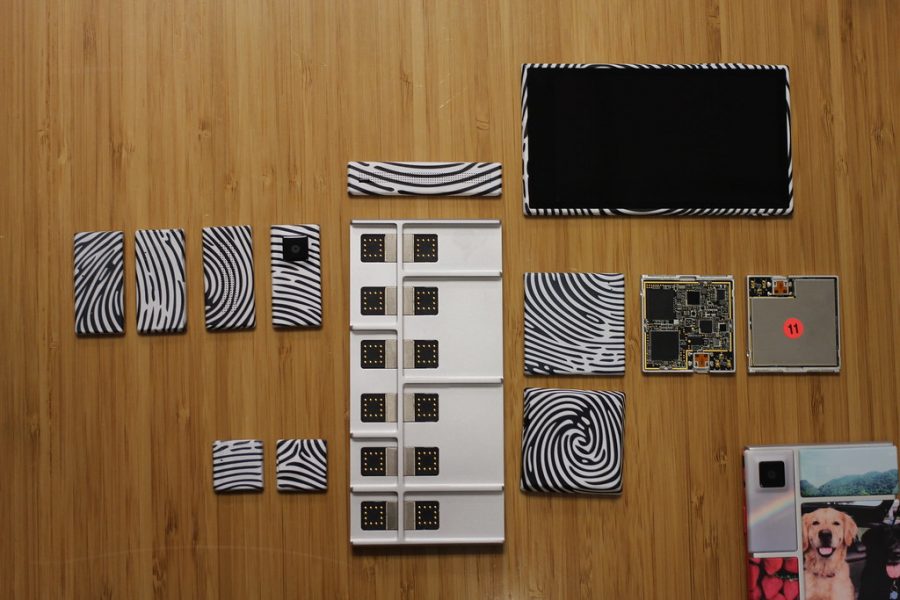Google Obtains a Patent for a Modular Smartphone
Google displays the modules of the Project Ara prototype.
In 2019, two of Google’s patents for modular smartphones were published. Modular smartphones are smartphones that include a main body which additional components, called modules, attach onto. These smartphones can eliminate electronic waste as when one component malfunctions or becomes outdated, only that component, rather than the whole smartphone, has to be replaced.
One of Google’s patents shows a main chassis which add-ons attach to. This model includes separate components for screens and front and rear cameras. Additional modules include extra battery, fitness tracker, additional cameras, extra memory, auxiliary display, and extra scanners. Another patent is similar to Project Ara, Google’s previous attempt at releasing a modular smartphone to the public, with multiple add-ons that slot into the main component. Each of these add-ons is capable of being individually controlled, in addition to being controlled through the device’s operating system. These designs are an improvement upon current modular smartphones on the market, like Motorola’s Moto Mods, which only allow for one module to be attached at a time.
Project Ara, announced on Oct 29, 2013, focused on developing a modular smartphone device that allowed the user to easily replace its components and was headed by the Advanced Technology and Projects (ATAP) team within Google. The design was intended to include an endo, or metal frame, that the other components, including processor, battery, camera, displays, storage, and speaker, could be added to. Other modules, such as laser pointers, pico projectors, night vision sensors, game controller buttons, receipt printers, medical devices, WiFi modules, were also considered for the future.
According to Daily Wireless, Google’s Paul Eremenko said the following about Project Ara smartphones: “It was designed to be utilized by “6 billion people”: 1 billion current smartphone users, and 5 billion future phone users.”
To allow for accessibility, there was to be a $50 starter kit including the endo (metal frame), entry level CPU, WiFi, battery, display. There were going to be three sizes of endos: a mini endo (same size as Nokia 3310), a medium-sized endo (same size as Nexus 5), and a large endo (same size as Samsung Galaxy Note 3).
Project Ara’s prototype, Spiral 1, was demonstrated at Google I/O in June 2014. Spiral 2 was scheduled to be released in Puerto Rico in 2015 but it was delayed indefinitely and scheduled to be released in some locations in the US in 2016 instead. In 2016, some changes were made to Spiral 2. The endo was made to come with an integrated circuit joining antenna, display, sensor, CPU, storage, but there were still changeable modules for camera, microphones, batteries, and speakers.
However, in Sept 2016, Google announced that they would shelve out Project Ara to concentrate on other hardware projects. This could be due to many factors. Big mobile phone industries were threatened by Project Ara and therefore tried to keep it off the market. Also, the technology available was not advanced enough to support Project Ara, creating several issues for developers to work to overcome. In addition, chances are that users who are not tech geeks do not want to think about what components they need to buy for their phone, and they want a certain brand, just to be fashionable.
According to Gabriel Sternburg, an 11th grade SMCS student, “Especially with smartphones, there’s like almost an absurd level of customer loyalty.”
One of the draws of Project Ara is reduced electronic waste, but as the hardware components in phones rapidly improve, users would have to continually upgrade their modules.
“If it’s a part that, like a screen, which is broken often, then that would create a lot of waste because people would just replace the screen as opposed to now when people have cracked screens just deal with the cracked screen for a while until other things stop working,” stated Sternburg.
Google planned to license Project Ara’s technology out to other companies, but no deals have been made yet.
Google’s recent patents show that Google has been looking into modular smartphones again. However, this does not guarantee that Google will restart Project Ara or launch a new project for developing modular phones.

Sanjana Mayenkar is a Senior in SMCS who strives to report on a variety of issues important to the Poolesville community. Even though this is her first...









